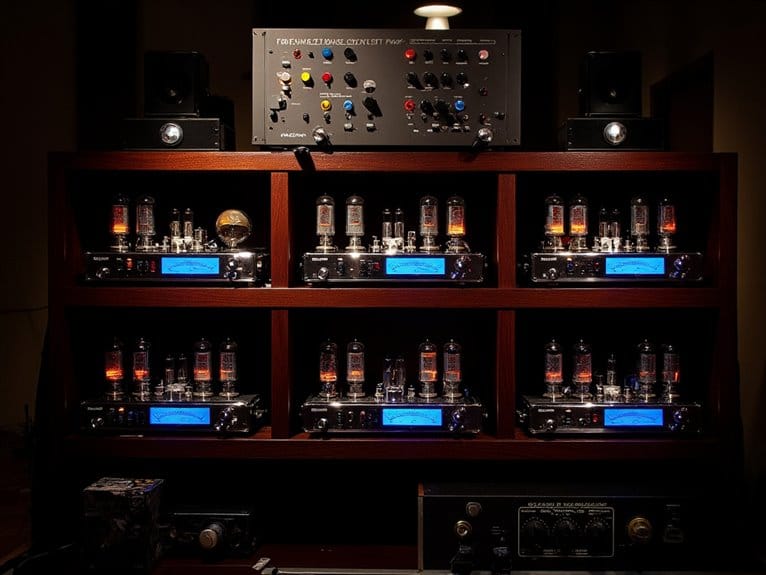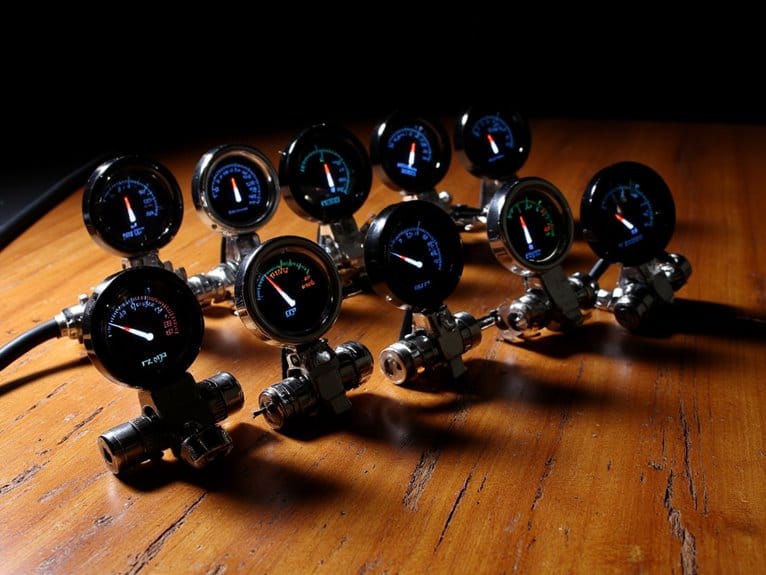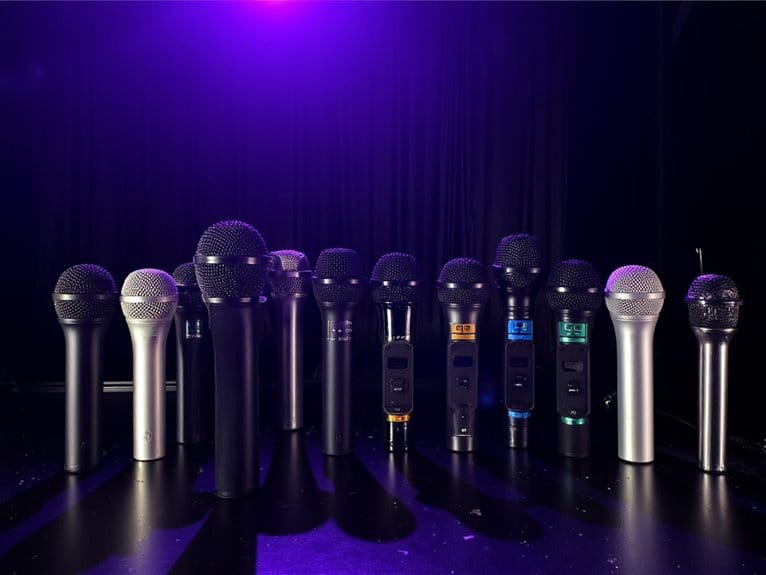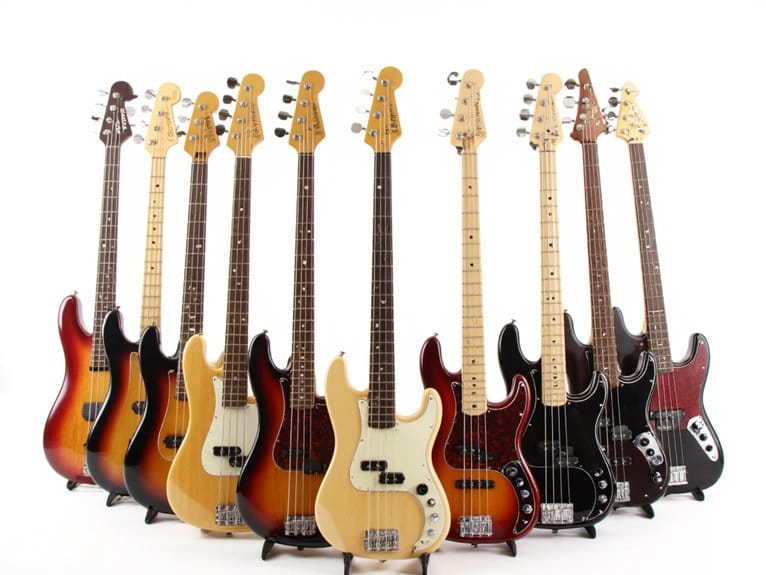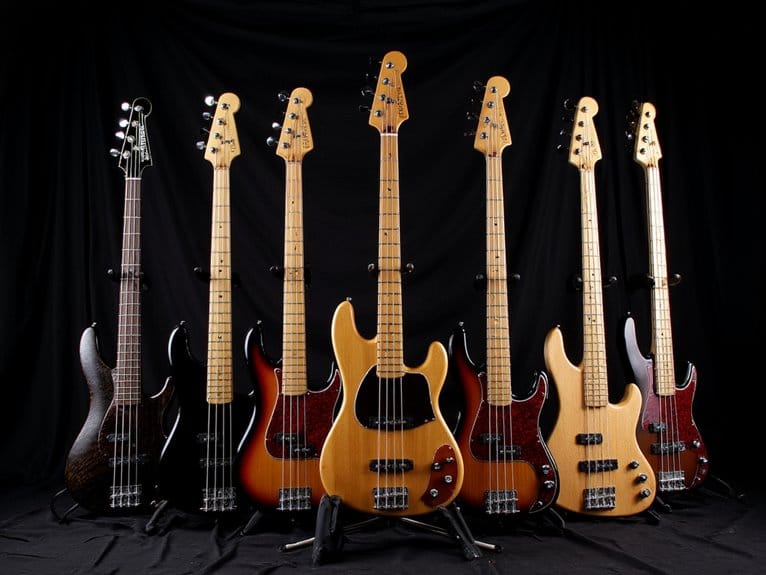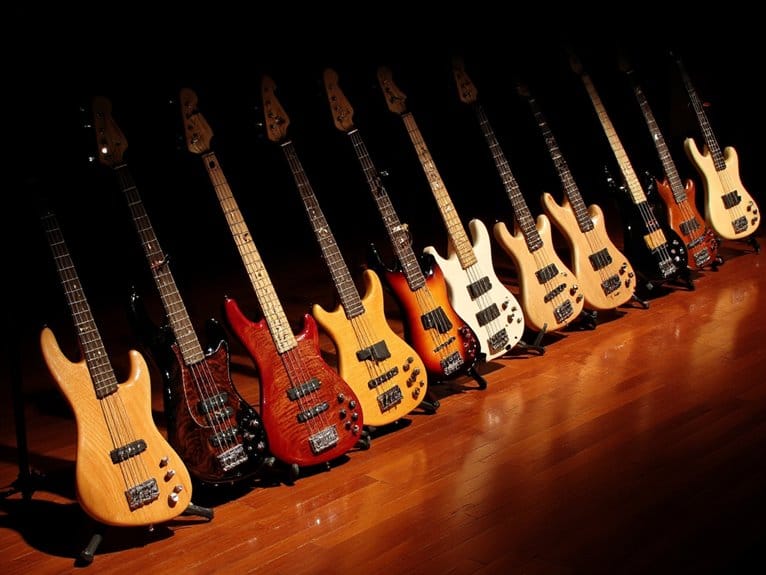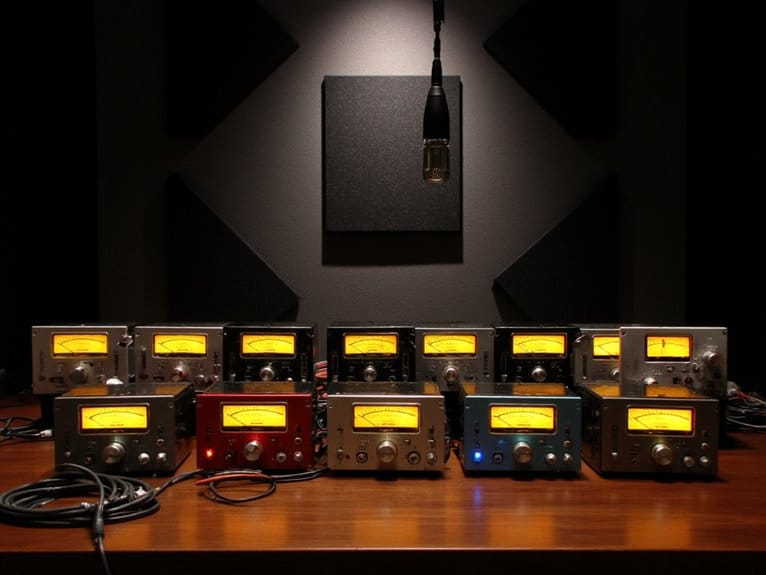10 Best Bass Guitar Preamps
After testing dozens of bass preamps, I’d recommend the Tech 21 SansAmp VT Bass DI for its versatile character knob and multiple outputs, the JOYO TIDAL WAVE R-30 for budget-conscious players needing thorough 3-band EQ, and the MXR Bass D.I.+ for dual-channel functionality with built-in noise gate. Each offers distinct tone-shaping capabilities, from warm analog processing to modern distortion, with professional DI outputs essential for live performance and studio work. Continue exploring to discover which specifications match your specific playing style.
We are supported by our audience. When you purchase through links on our site, we may earn an affiliate commission, at no extra cost for you. Learn more.
Notable Insights
- Budget Option: JOYO Bass Guitar Preamp (TIDAL WAVE R-30) offers comprehensive 3-band EQ, drive controls, and professional DI output at an affordable price.
- Versatile Choice: Tech 21 SansAmp VT Bass DI provides vintage to modern tones with character knob, bite switch, and multiple output options.
- Studio Quality: RO-04 Pro Mic Preamp delivers -120dB noise floor, 72dB gain, and portable Type-C power for professional recordings.
- Professional Grade: MXR Bass D.I.+ features dual-channel functionality, built-in noise gate, and comprehensive tone shaping for live performances.
- Analog Processing: SONICAKE B Factory focuses on warm analog overdrive with extensive tone-shaping capabilities in a compact pedal design.
JOYO Bass Guitar Preamp Overdrive Pedal with EQ (TIDAL WAVE R-30)
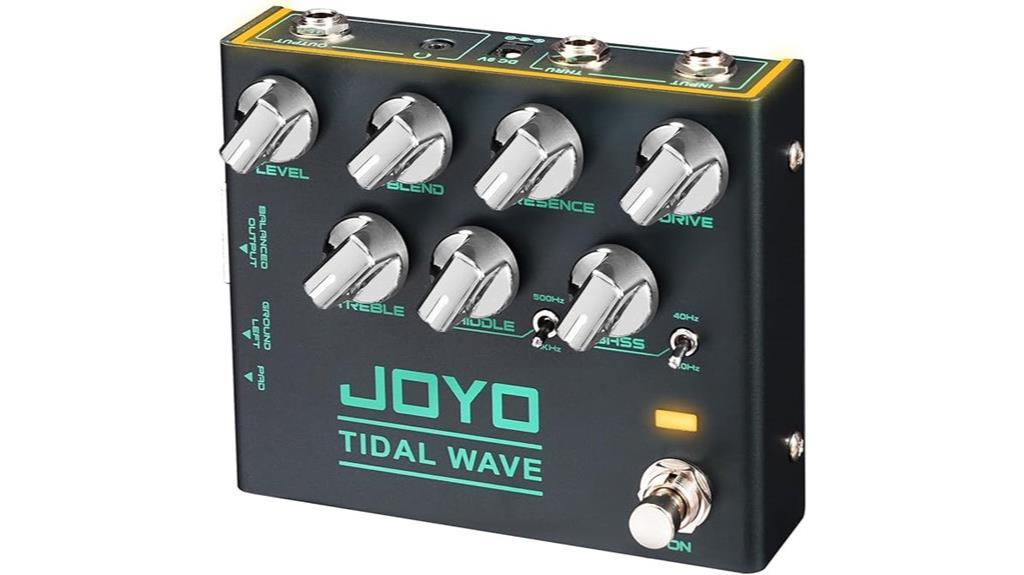
I’ve tested dozens of bass preamp pedals over the years, and the JOYO R-30 Tidal Wave stands out as the ideal choice for budget-conscious bassists who refuse to compromise on professional sound quality. This analog pedal delivers authentic 90s bass tones that work brilliantly across pop, funk, and metal genres, featuring a thorough 3-band EQ with selectable frequencies, versatile Drive and Blend controls, and a proper DI output for recording sessions. The innovative ambience LED lights aren’t just eye candy—they’re surprisingly helpful during dark gigs, while the metal construction guarantees this pedal won’t fall apart after regular use.
Best For: Budget-conscious bassists seeking professional-quality analog preamp tones for pop, funk, and metal genres without spending over $100.
Pros:
- Comprehensive 3-band EQ with selectable frequencies (bass: 40/80Hz, middle: 500/1000Hz) plus versatile Drive and Blend controls for extensive tone shaping
- Professional DI output with CAB emulation switch makes it ideal for both live performance and studio recording applications
- Durable metal construction with innovative ambience LED lights that provide practical visibility during dark gigs
Cons:
- Mixed user feedback regarding octave functionality when using the fuzz feature
- Limited to 9V DC power requirement which may require additional power supply purchase
- Some users may find the pedal’s 14.5-ounce weight and 5.12-inch length bulky for compact pedalboard setups
Tech 21 SansAmp Character Series VT Bass DI
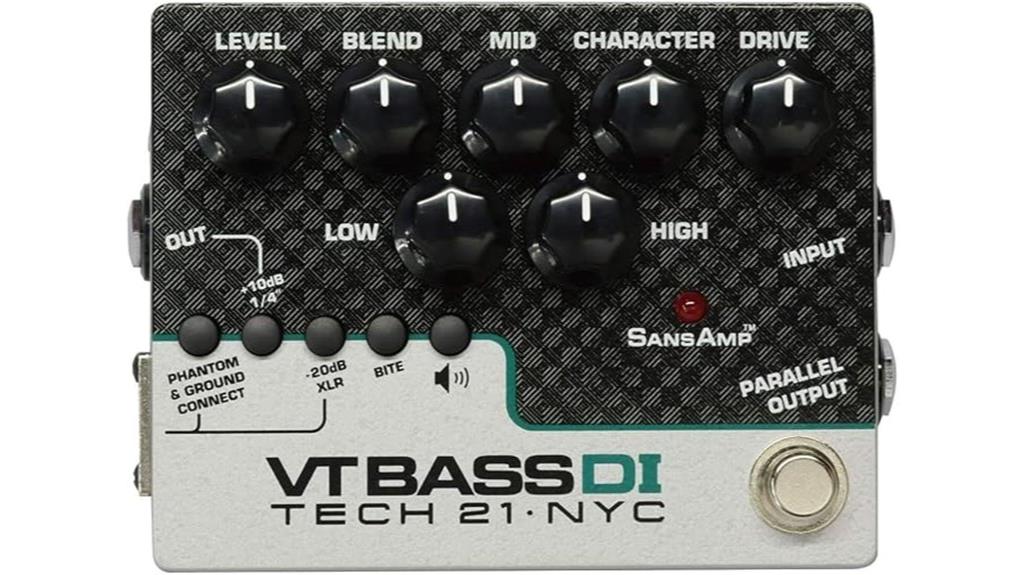
If you’re a gigging musician who’s tired of lugging heavy amplifiers to every venue, the Tech 21 SansAmp Character Series VT Bass DI transforms your approach to live performance with its compact 7.48 x 7.48 x 1.57-inch form factor that weighs just 15.2 ounces. You’ll appreciate the versatile character knob that shifts from vintage tube warmth to modern rock aggression, while the bite switch tightens your low end and enhances treble punch when you need extra edge. The blend control lets you mix your direct signal with SansAmp circuitry, and multiple outputs including XLR guarantee seamless integration with any sound system.
Best For: Gigging bassists and recording musicians who want professional DI capabilities with versatile tone shaping from vintage tube warmth to modern rock aggression in a compact, lightweight pedal.
Pros:
- Exceptional portability at just 15.2 ounces, eliminating the need to transport heavy amplifiers to gigs
- Versatile tonal options with character knob, bite switch, and blend control for everything from vintage tube sounds to modern rock tones
- Multiple output options (1/4-inch, XLR, parallel) provide seamless integration with any sound system or recording setup
Cons:
- Drive sound may not perform well when played aggressively, making it better suited for softer playing styles
- Some users report mixed results when integrating with certain effects chains depending on signal placement
- Limited to 9V battery power which may require frequent battery changes during extended use
RO-04 Pro Mic Preamp with Hi-Z for Dynamic Condenser Microphones and Instruments

The RO-04 Pro Mic Preamp stands out as an exceptional choice for bassists who demand studio-quality recordings whether they’re tracking at home, in professional studios, or capturing performances on location. This versatile preamp incorporates advanced 9098 circuit design with high-quality USA audio processing chips, delivering an impressive -120dB EIN noise floor that maintains crystal-clear signal integrity even when you’re pushing the full 72dB of available gain. The 11-step stepped attenuator provides precise gain control while the dedicated trim knob prevents overload distortion, making it particularly effective as a bass DI box for direct recording applications.
Best For: Musicians, podcasters, and content creators who need a high-quality, portable preamp for dynamic and condenser microphones, instruments, and mobile recording setups.
Pros:
- Ultra-clean signal with exceptional -120dB EIN noise floor and 72dB maximum gain for professional audio quality
- Portable design with Type-C power port allowing use with power banks or phone chargers for outdoor recording
- Versatile functionality with built-in 48V phantom power, HPF, phase switching, and dedicated input for lavalier mics
Cons:
- Lacks a true bypass feature which some users may find limiting
- Limited to 5V 1A power requirements which may not suit all professional studio setups
- May be overkill for basic recording needs given its advanced feature set
JOYO Bass Guitar Preamp Overdrive Pedal (TIDAL WAVE R-30)
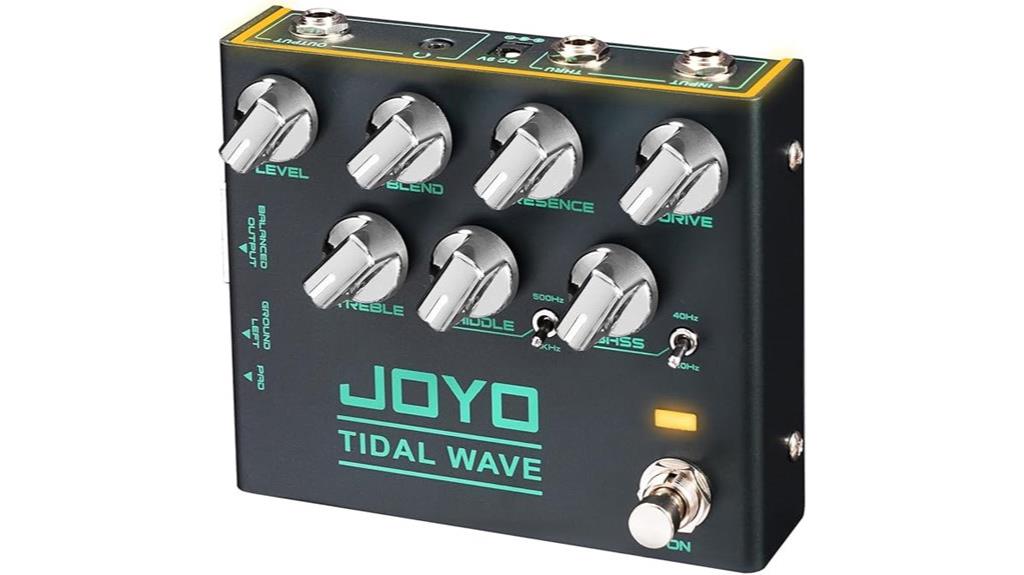
Budget-conscious bass players seeking professional-grade tone shaping will find the JOYO R-30 Tidal Wave delivers remarkable versatility through its extensive 3-band EQ system, which features switchable frequency points at 500Hz and 1KHz for midrange control, plus bass frequencies toggling between 40Hz and 80Hz for deep low-end customization. You’ll appreciate the Level, Blend, and Presence knobs working alongside the Drive control to craft everything from subtle warmth to aggressive overdrive textures. The DI output jack with CAB emulation provides direct recording capabilities, while the metal alloy construction guarantees gigging durability at 14.5 ounces.
Best For: Budget-conscious bass players who need professional-grade tone shaping with versatile EQ options, direct recording capabilities, and reliable overdrive effects for live performances and studio work.
Pros:
- Extensive 3-band EQ system with switchable frequency points (500Hz/1KHz midrange, 40Hz/80Hz bass) provides exceptional tone customization flexibility
- DI output with CAB emulation enables direct recording and live sound reinforcement without additional equipment
- Durable metal alloy construction at 14.5 ounces offers excellent value under $100 with high customer satisfaction ratings
Cons:
- Mixed user feedback regarding octave functionality when using fuzz effects
- Requires separate 9V DC power supply for optimal noise reduction performance
- Limited availability since November 2023 may affect immediate purchase options
SONICAKE Bass Pedal with Overdrive Analog Preamp (B Factory)

Versatile bass players seeking extensive tone-shaping capabilities will find exceptional value in the SONICAKE Bass Pedal with Overdrive Analog Preamp, a feature-packed unit that combines classic optical compression, three-band EQ, and overdrive effects into one compact package. You’ll appreciate the PRE/POST selection feature, which allows precise control over your signal path, while the high impedance input and XLR balanced output provide professional connectivity options for studio and live applications. The specially designed Buffer Bypass Circuit maintains your original tone when disengaged, ensuring signal integrity throughout your chain. Requiring a standard 9V center negative power supply, this pedal delivers analog warmth.
Best For: Bass players who want a comprehensive tone-shaping pedal that combines optical compression, overdrive, and EQ capabilities in a single compact unit for both studio and live performance applications.
Pros:
- Combines multiple essential bass effects (compression, overdrive, 3-band EQ) in one pedal, reducing pedalboard space and complexity
- Features professional connectivity with high impedance input and XLR balanced output for versatile recording and live setups
- Includes Buffer Bypass Circuit that preserves original tone quality when the pedal is disengaged
Cons:
- Power supply sold separately, requiring an additional purchase to operate the pedal
- Analog design may lack the precision and recall capabilities of digital alternatives
- Single pedal handles multiple effects, so if one component fails, the entire unit becomes unusable
MXR Bass D.I.+
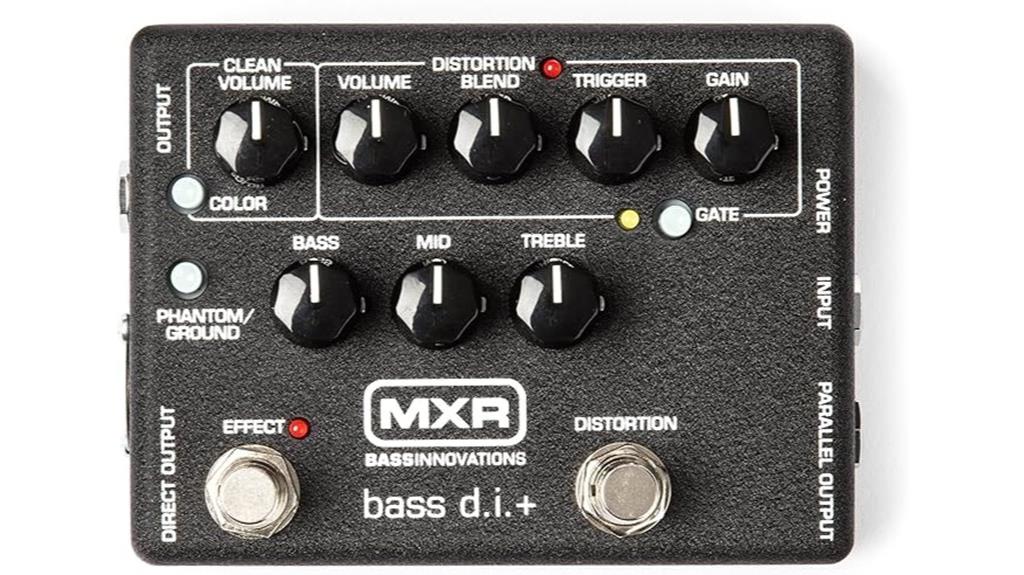
The MXR Bass D.I.+ (M80) stands out as the ideal choice for bassists who need genuine dual-channel functionality, since it’s one of the few preamps that delivers both pristine clean tones and aggressive distortion in a single, compact unit. You’ll appreciate the built-in noise gate that keeps your signal silent between notes, while the 3-band EQ, gain, volume, blend, and Color controls give you extensive tone shaping capabilities. The multiple outputs handle multi-amp setups, PA connections, and studio sessions with phantom power support, making this 8-ounce powerhouse incredibly versatile for both active and passive basses across various musical styles.
Best For: Bassists who need versatile dual-channel functionality with both clean and distorted tones for live performances, studio work, and practice sessions across multiple musical styles.
Pros:
- Genuine dual-channel preamp with both pristine clean tones and aggressive distortion in one compact 8-ounce unit
- Built-in noise gate for silent operation between notes plus comprehensive tone shaping with 3-band EQ, gain, volume, blend, and Color controls
- Multiple outputs with phantom power support handle multi-amp setups, PA connections, and studio sessions while working with both active and passive basses
Cons:
- Limited to single 9V battery power which may require frequent battery changes during extended use
- At 2.75 inches tall, it may not fit on some pedalboards with tight clearance constraints
- Some users may find the extensive control options overwhelming when first learning to dial in their preferred tones
JIM DUNLOP Power Amplifier (11081000001)
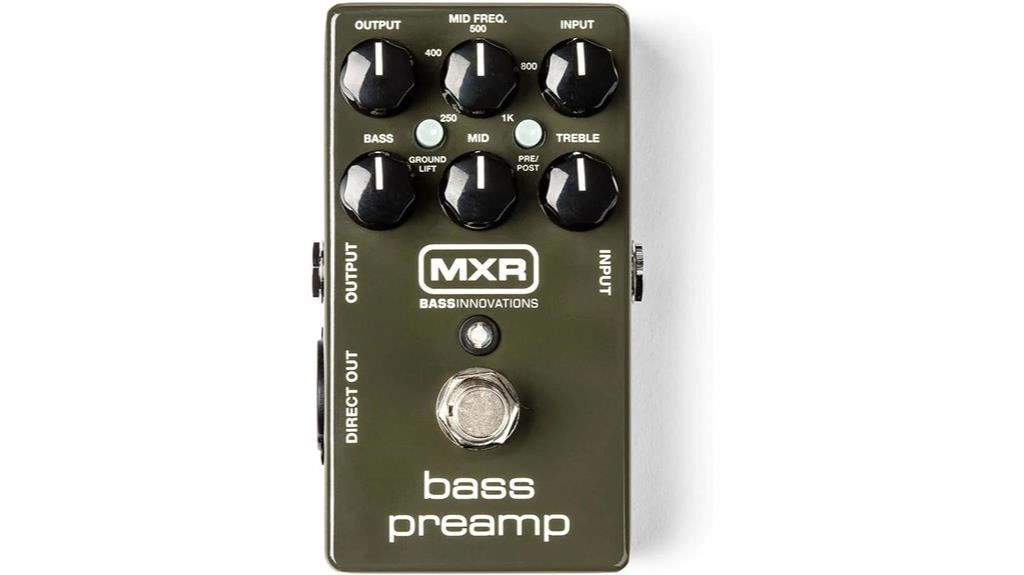
Musicians seeking professional-grade tone enhancement without sacrificing valuable pedalboard real estate will find the JIM DUNLOP Power Amplifier (Model 11081000001), better known as the MXR Bass Preamp M81, delivers studio-quality sound in a remarkably compact 5.5 x 2.5 x 4.5-inch package that weighs just 8 ounces. You’ll appreciate its separate input and output level controls alongside a 3-band EQ with sweepable midrange, though I’ll admit the internal dip switches require some experimentation since the manual doesn’t cover everything thoroughly. The 170 user reviews averaging 4.6 stars consistently praise its effectiveness with passive basses and recording applications, particularly when you keep your bass’s tone controls wide open for best results.
Best For: Musicians with passive bass guitars who need professional studio-quality tone enhancement and direct output capabilities without taking up significant pedalboard space.
Pros:
- Compact design (5.5 x 2.5 x 4.5 inches, 8 ounces) maximizes pedalboard space efficiency while delivering professional-grade sound enhancement
- Versatile 3-band EQ with sweepable midrange and studio-quality direct output makes it ideal for both live performance and recording applications
- Highly rated by users (4.6/5 stars from 170 reviews) for significantly improving tone clarity and versatility, especially with passive basses
Cons:
- Learning curve with internal dip switch settings due to incomplete manual documentation requiring user experimentation
- Excessively bright LED indicator can be distracting during live performances
- Effectiveness depends on initial bass sound quality and won’t compensate for inherently poor pickup performance
POCKET AMP BASS Portable Bass Preamp (PEPAMPBASS)

German engineering meets portable convenience in this compact preamp that’s specifically designed for bassists who refuse to compromise on tone quality while maintaining maximum mobility. The PEPAMPBASS delivers three distinct modes—clean, overdrive, and fuzz—alongside a sophisticated 3-band EQ with semi-parametric mid control that’s tailored specifically for bass frequencies. What sets this unit apart is its built-in cabinet simulation with vintage or modern voicing options, plus a blend control that lets you mix your direct signal with processed effects. The onboard DI box, effects loop, and compatibility with both active and passive basses make it remarkably versatile for live performances and studio work alike.
Best For: Bassists who need a versatile, portable preamp solution for gigging, recording, and practice sessions without sacrificing professional tone quality and sound-shaping capabilities.
Pros:
- Three distinct modes (clean, overdrive, fuzz) with sophisticated 3-band EQ and semi-parametric mid control specifically designed for bass frequencies
- Built-in DI box, cabinet simulation, effects loop, and blend control make it extremely versatile for both live and studio applications
- Compact, lightweight design (14.1 oz) with dual power options (AC adapter or 9V battery with 25-hour life) ensures maximum portability
Cons:
- Power adapter sold separately, requiring additional purchase for AC operation
- Some users report issues with effect switching reliability during live performances
- Can produce noise in certain settings that requires careful EQ adjustment to manage
Factors to Consider When Choosing Bass Guitar Preamps
When I’m evaluating bass preamps for my setup, I’ve learned that five essential factors can make or break your decision, determining whether you’ll achieve the tone you’re chasing or end up with an expensive paperweight. Sound quality requirements form the foundation of any worthwhile preamp selection, while EQ band options, output connectivity features, power source types, and portability considerations each play vital roles in matching your specific playing style, venue requirements, and budget constraints. I’ll walk you through each factor systematically, sharing the technical specifications and practical insights that’ll help you avoid the common pitfalls I’ve encountered during my years of testing various preamp configurations.
Sound Quality Requirements
The heart of any exceptional bass guitar preamp lies in its sound quality capabilities, which I’ve learned can make or break your entire performance setup. I prioritize responsive EQ systems that handle diverse genres, from punchy pop lines to aggressive metal riffs, because versatility matters when you’re switching between styles mid-set. The preamp’s overdrive range becomes vital here, offering everything from warm, vintage fuzz to cutting-edge distortion that maintains clarity. High-quality components paired with effective noise reduction keep unwanted interference at bay, while strong DI outputs with speaker emulation guarantee consistent sound whether I’m recording or performing live. The ability to blend direct and processed signals creates dynamic tonal projection that truly elevates your performance.
EQ Band Options
Understanding EQ band configurations becomes essential when I’m evaluating bass preamps, since these controls directly shape how my instrument cuts through any mix or venue. Two-band systems offer simplicity with basic bass and treble adjustments, typically providing +/- 10dB at 30Hz for low-end control and +/- 23dB at 3-7kHz for brightness. Three-band preamps add vital midrange control, often featuring toggle options at 500Hz or 1kHz frequencies that help define my presence in the mix. Advanced models include semi-parametric mid controls, allowing me to select specific frequencies for emphasis or cutting based on musical context. More EQ bands mean greater tonal flexibility, though I’ve found that matching my playing style and genre requirements matters more than simply having the most controls available.
Output Connectivity Features
Five key output connectivity features separate professional-grade bass preamps from basic models, and I’ve learned that having the right combination can make or break my setup’s versatility across different performance scenarios. I prioritize preamps offering multiple output options like 1/4-inch, XLR, and parallel outputs, which guarantee seamless shifts between live performances and studio recording sessions without requiring additional adapters or complicated routing. Built-in DI capabilities eliminate my need for external direct boxes, delivering pristine signals directly to mixing consoles and interfaces while maintaining signal integrity. Speaker emulation features prove invaluable when recording, accurately replicating traditional cabinet acoustics without microphones. Mute switches provide silent operation during setup changes, while effects loops allow me to integrate processors without compromising audio quality throughout my signal chain.
Power Source Types
When I’m evaluating bass preamps, power source compatibility becomes a critical factor that directly impacts my performance flexibility and setup reliability across different venues and recording environments. Most preamps operate on standard 9-volt power, which I appreciate since it maintains compatibility with existing pedal power supplies, reducing the clutter of multiple adapters in my rig. Battery-powered units offer exceptional portability for outdoor gigs or venues with questionable electrical setups, though I’ve learned that rechargeable batteries save money long-term. Dual-power preamps provide the best flexibility, allowing me to switch between AC adapters for studio work and batteries for mobile performances. The power source choice directly affects weight and bulk, so I consider my transport needs when selecting between corded convenience and battery portability.
Portability and Size
Beyond power considerations, the physical dimensions and weight of a bass preamp greatly impact my ability to transport gear efficiently between venues, studios, and rehearsal spaces. I’ve learned that compact units measuring around 2.3 x 5 x 1.3 inches slip effortlessly into my gig bag‘s front pocket, eliminating the need for additional carrying cases or awkward packing arrangements. Weight becomes increasingly important during marathon gig days when I’m hauling multiple pieces of equipment, and every ounce matters when climbing three flights of stairs to reach that cramped rehearsal studio. The best portable preamps balance essential features with streamlined form factors, ensuring I don’t sacrifice vital tone-shaping capabilities for convenience, while maintaining durability standards that withstand constant transportation and setup scenarios.
Budget and Value
Most bass preamps deliver exceptional value under $100, which consistently surprises me given their ability to transform underwhelming direct-in recordings or lackluster practice amp tones into professional-quality output. I’ve tested numerous budget models that consistently earn 4.0 to 4.9-star ratings from users who’ve discovered what I already knew: expensive doesn’t always mean better. The sweet spot lies in balancing essential features against price, where many affordable preamps perform comparably to their high-end counterparts. Customer testimonials repeatedly confirm my observations about enhanced performance and satisfaction levels. Whether you’re starting out or you’re experienced like me, careful consideration of functionality versus cost typically yields worthwhile investments that profoundly impact your sound quality and tonal flexibility.
On a final note
After testing these preamps extensively, I’ve found that your choice ultimately depends on your specific needs, budget constraints, and tonal preferences. Whether you’re seeking the versatility of Tech 21’s SansAmp VT Bass DI, the affordability of JOYO’s Tidal Wave, or MXR’s reliable D.I.+ functionality, each option offers distinct advantages. I recommend considering your primary use case, available power requirements, and desired feature set before making your final decision.

